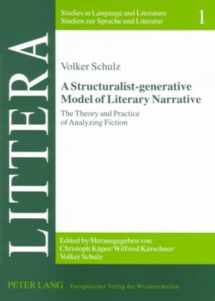
A Structuralist-generative Model of Literary Narrative: The Theory and Practice of Analyzing Fiction- Including an Essay by Stephan-Alexander Ditze (LITTERA)
ISBN-13:
9783631514085
ISBN-10:
3631514085
Edition:
New
Author:
Volker Schulz
Publication date:
2006
Publisher:
Peter Lang GmbH, Internationaler Verlag der Wissenschaften
Format:
Paperback
316 pages
FREE US shipping
Book details
ISBN-13:
9783631514085
ISBN-10:
3631514085
Edition:
New
Author:
Volker Schulz
Publication date:
2006
Publisher:
Peter Lang GmbH, Internationaler Verlag der Wissenschaften
Format:
Paperback
316 pages
Summary
A Structuralist-generative Model of Literary Narrative: The Theory and Practice of Analyzing Fiction- Including an Essay by Stephan-Alexander Ditze (LITTERA) (ISBN-13: 9783631514085 and ISBN-10: 3631514085), written by authors
Volker Schulz, was published by Peter Lang GmbH, Internationaler Verlag der Wissenschaften in 2006.
With an overall rating of 3.7 stars, it's a notable title among other
books. You can easily purchase or rent A Structuralist-generative Model of Literary Narrative: The Theory and Practice of Analyzing Fiction- Including an Essay by Stephan-Alexander Ditze (LITTERA) (Paperback) from BooksRun,
along with many other new and used
books
and textbooks.
And, if you're looking to sell your copy, our current buyback offer is $0.51.
Description
This study fills three of the most serious gaps in narrative theory and analysis of fiction. Firstly, it provides the long overdue, first genuinely comprehensive model of literary narrative («fiction»). Its «structuralist-generative» nature allows to integrate the findings of most major theorists of the twentieth century. The model is explained in detail and illustrated by a fold-out chart. Secondly, in contrast to structuralist narrative theory, the model is not a mere inventory of the various «units» of which a work of fiction consists. Rather, it elucidates the dynamic interplay of the literary narrative’s various content «components» and discourse «aspects» which convey its thematic idea. Thirdly, the feasibility of the model is extensively demonstrated by the (selective) analysis of several short stories, a novella and a novel. – In the appendix, a student paper shows the model’s heuristic-«didactic» power at the level of advanced literary studies.


We would LOVE it if you could help us and other readers by reviewing the book
Book review

Congratulations! We have received your book review.
{user}
{createdAt}
by {truncated_author}


